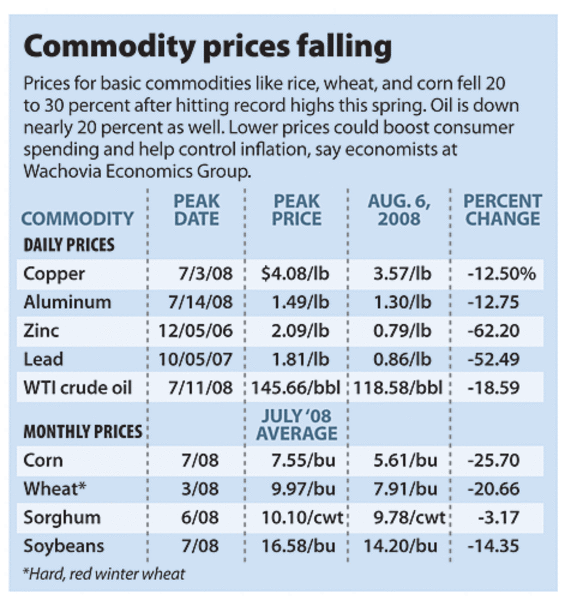Relief for consumers: prices falling
Loading...
| New York
After sprinting to record levels this spring, the prices for basic commodities have now fallen 20 to 30 percent.
Prices are now lower on staples such as rice, wheat, corn, and soybeans. Also down are prices for metals such as aluminum, zinc, and copper. The commodity almost everyone follows – oil – is off nearly 20 percent as well, dropping Friday to its lowest level since May 1.
Falling commodity prices have important economic implications. They may indicate that the global economy – especially in terms of the role played by fast-growing countries such as China – is beginning to slow. The prices also take some pressure off the Federal Reserve to hike interest rates to counter inflation. Last Tuesday, the Fed kept short-term rates unchanged, but it did indicate it was still concerned about inflation.
The decline in commodity prices, if it continues, could also give consumers a little more money in their wallets to pay for something other than gasoline and groceries.
"The falling prices helps shore up consumer spending and also has an effect on inflation," says Jay Bryson, global economist at Wachovia Economics Group in Charlotte, N.C. "The Fed probably does not need to tighten interest rates now."
The prospect of interest rates remaining at low levels helped ignite a significant rally in the stock market last Tuesday, when the Dow Jones Industrial Average climbed 331 points. On Friday, the rally continued, with the Dow climbing 302.89 points to close the week at 11734.32.
Although it may be too soon for the falling prices to be reflected in national inflation statistics, some of them are starting to work their way through to Americans' wallets. Last week, for example, King Arthur Flour reduced the prices on four grades of its product by 15 percent. On April 1, the company, which makes premium flour, had increased prices by 46 percent. "That price increase did not cover the difference in our costs," says Michael Bittel, senior vice president and general manager of the Norwich, Vt., company. Nevertheless, King Arthur Flour went ahead with a price decrease. "We were hoping the price would come down and we could pass that reduction back to our customers," Mr. Bittel says.
Good conditions for growing crops are partly why the grain markets have dropped in price, says William Lapp, president of Advanced Economic Solutions in Omaha, Neb. "We've had frequent rain events and no persistent heat to affect yields, so the crop is off to a decent start," says Mr. Lapp, adding, "But the questions remain: Will we have a long enough growing season since it's been cooler than normal, and how much of the crop was drowned out this spring?"
On Tuesday, some of the questions will be answered when the US Department of Agriculture (USDA) gives its first official crop report. "Usually they are accurate to within about 5 percent of the crop estimate," says Lapp, a former chief economist at ConAgra Foods.
Despite the current decline in grain prices, they remain high on a historical basis. For example, corn prices are historically between $2 and $3 a bushel. They are now $5 a bushel, down from $8 a bushel. "It's kind of like calling gasoline at $3.50 a gallon cheap," Lapp says.
Rice, another key food commodity, has also declined in price. Earlier this year, rough rice was selling for as much as $25 per 100 pounds on the Chicago Board of Trade. Now, it's close to $16 per 100 pounds, a decline of 36 percent. However, it is still about 60 percent higher than it was last year at this time.
"There was real concern about the Asian crops [and] strong import demand from the Philippines. And people went into a panic mode over food security concerns," says Tom Tice, director of food grains analysis at the USDA in Washington. "Now, the panic-buying is out, and importers are waiting for the crops from Thailand and Vietnam."
The new rice crop is being harvested in Texas and parts of Southeast Asia. The rice crop from Arkansas will not come until late September, about three weeks later than normal. But, Mr. Tice says, in mid-July it appeared that the crop conditions were comparable to last year, which was a very good year. On Tuesday, the USDA will be releasing new estimates.
Even though some commodities have come down in price, some of the reductions have yet to be reflected in retail prices – for example, in copper and plastic piping. That's the case at Mayer Malbin Inc., a leading supplier of pipes, valves, and fittings in Long Island City in New York, says Jonathan Gordon, a vice president.
"We're seeing more increases, not falling prices," Mr. Gordon says. "Maybe from its high the price is down 10 percent, but we've seen price increases at the wholesale level of 40 percent to 50 percent since the beginning of the year. The basic cost to build something is so much higher than six months ago."
Even though prices are much higher in Portland, Ore., Dan O'Brien, president of Current Electrical, expects to see a "softening." "Demand is down, so they have to do something," says Mr. O'Brien, whose products include copper, aluminum, and steel.
Ken Simonson, chief economist at the Associated General Contractors of America, says he is getting reports of increases in wallboard, an essential element in the construction industry. "We've gotten several examples of increases for August, September, and October of 10 to 12 percent each month," he says. "But I find it extremely hard to believe the price increases will stick given the weak housing market."






